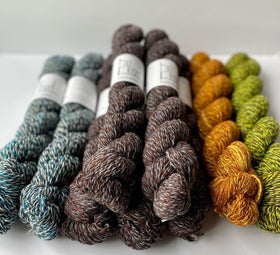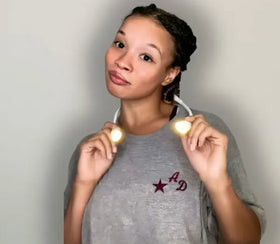
Adult swim - let's talk about pooling
by Meg Dedolph
Not the kind with water and deck chairs, where I hope you’re spending a little time this summer, but that thing some of the more colorful variegated yarns like to do.

Sister Ananse is known for beautiful variegated colors.
If a yarn has long stretches of different colors, depending on the item you’re knitting, those colors may stack up in blotches across your knitted piece.
You might like the way this looks. Or you might not. Some people like an element of surprise in their knitting, and some people don’t.
But it’s helpful to know pooling when you see it so you can use it to your advantage.
Lately, some designers have been writing fun patterns for “planned pooling” yarns. All that means is, every time you reach a particular color in the skein, you work a different stitch.
While some companies sell yarns made specifically for these patterns, you can use any variegated yarn with long repeats (several inches) of different colors. Just pick the color you want to use for the accent stitch and carry on with the pattern.
Whether or not a yarn pools depends mostly on how wide your knitted or crocheted piece is. Here’s photos of the same shawl. (Pooling Party by Beth McNish) You can see how, at the narrower end, the yarn colors appear different than they do at a wider point on the shawl.


The blue and yellow make thin pinstripes when the shawl is narrower, and as it gets wider, the blue and brown stripe, and the yellow appears in larger blocks of color.
The overall effect is a big wash of three colors and it looks great, especially with the different textures from the different stitches.
If you don’t like the way the colors are stacking up in your piece, it may mean that the yarn is the wrong choice for that piece and might be better used elsewhere. The main photo for this entry, with a row of multicolored socks shows the same yarn that Beth used in her shawl - just knit up over a different number of stitches.
Sometimes combining a pooling yarn with a solid or tonal solid can mute the effects of the pooling. Here’s a shawl (Boomerangle by Nim Teasdale) that I knitted with a pooling yarn out of my stash combined with a skein of blue Malabrigo Rios. The blue breaks up the pooling and I was much happier with the result. Same with the socks below, which mixed stash yarn with Keenan fingering weight in green in a helical knitting pattern that I made up as I went along.


Other times, using the pooling yarn as the variegated yarn in a colorwork pattern makes the pooling less obvious. Here’s another example of a cowl knit with a skein of the Dream In Color planned pooling yarn, where I loved the colors, but didn't want it to pool. (Hella Flower Power, by Catherine Clark.)

So whether you love pooling yarns or not, we can help you find a way to use that colorful skein of yarn in a pattern you’ll have fun knitting. 
📌 Save this Pin for Later!




Leave a comment